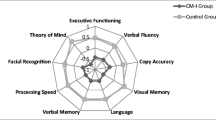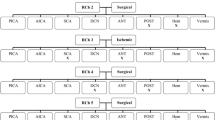Abstract
Type I Chiari malformation (CMI) is a neurological condition in which the cerebellar tonsils descend into the cervical spinal subarachnoid space resulting in cervico-medullary compression. Early case-control investigations have indicated cognitive deficits in the areas of attention, memory, processing speed, and visuospatial function. The present study further examined cognitive and emotional processing deficits associated with CMI using a dual-task paradigm. Nineteen CMI patients were recruited during pre-surgical consultation and 19 matched control participants identified emotional expressions in separate single and asynchronous dual-task designs. To extend earlier behavioral studies of cognitive effects in CMI, we recorded event-related potentials (ERPs) in the dual-task design. Though response times were slower for CMI patients across the two tasks, behavioral and ERP analyses indicated that patients did not differ from matched controls in the ability to allocate attentional resources between the two tasks. P1 ERP component analyses provided no indication of an emotional arousal deficit in our CMI sample while P3 ERP component analyses suggested a CMI-related deficit in emotional regulation. P3 analysis also yielded evidence for a frontalization of neurophysiological activity in CMI patients. Pain and related depression and anxiety factors accounted for CMI deficits in single-task, but not dual-task, response times. Results are consistent with a dysfunctional fronto-parietal attentional network resulting from either the indirect effects of chronic pain or the direct effects of CMI pathophysiology stemming from cervico-medullary compression.





Similar content being viewed by others
References
Allen PA, Delahanty D, Kaut KP, Li X, Garcia M, Houston JR, et al. Chiari 1000 Registry Project: assessment of surgical outcome on self-focused attention, pain and delayed recall. Psychol Med. 2017. https://doi.org/10.1017/S0033291717003117.
Allen, P. A., Houston, J. R., Pollock, J. W., Buzzelli, C., Li, X., Harrington, A. K., … Luciano, M. G. (2014) Task-specific and general cognitive effects in Chiari malformation type I. PLoS One, 9(4), e94844, DOI: https://doi.org/10.1371/journal.pone.0094844.
Apkarian AV, et al. Chronic pain patients are impaired on an emotional decision-making task. Pain. 2004;108(1–2):129–36. https://doi.org/10.1016/j.pain.2003.12.015.
Attridge N, Noonan D, Eccleston C, Keogh E. The disruptive effects of pain on n-back task performance in a large general population sample. Pain. 2015;156(10):1885–91. https://doi.org/10.1097/j.pain.0000000000000245.
Batty M, Taylor MJ. Early processing of the six basic facial emotional expressions. Cogn Brain Res. 2003;17(3):613–20. https://doi.org/10.1016/S0926-6410(03)00174-5.
Bechara A, Damasio AR, Damasio H, Anderson SW. Insensitivity to future consequences following damage to human prefrontal cortex. Cognition. 1994;50(1):7–15. https://doi.org/10.1016/0010-0277(94)90018-3.
Benjamin Y, Yekutieli D. The control of the false discovery rate in multiple testing under dependency. Ann Stat. 2001;29(4):1165–88.
Berryman C, Stanton TR, Bowering KJ, Tabor A, McFarlane A, Moseley GL. Do people with chronic pain have impaired executive function? A meta-analytical review. Clin Psychol Rev. 2014;34(7):563–79. https://doi.org/10.1016/j.cpr.2014.08.003.
Bushnell MC, Čeko M, Low LA. Cognitive and emotional control of pain and its disruption in chronic pain. Nat Rev Neurosci. 2013;14(7):502–11. https://doi.org/10.1038/nrn3516.
Cappell KA, Gmeindl L, Reuter-Lorenz PA. Age differences in prefontal recruitment during verbal working memory maintenance depend on memory load. Cortex. 2010;46(4):462–73. https://doi.org/10.1016/j.cortex.2009.11.009.
Carrier LM, Pashler H. Attentional limits in memory retrieval. J Exp Psychol: Learn Mem Cognit. 1995;21(5):1339–48.
Corbetta M, Shulman GL. Control of goal-directed and stimulus-driven attention in the brain. Nat Rev Neurosci. 2002;3(3):201–15. https://doi.org/10.1038/nrn755.
Dehaene S, Changeux J-P. Experimental and theoretical approaches to conscious processing. Neuron. 2011;70(2):200–27. https://doi.org/10.1016/j.neuron.2011.03.018.
Delorme A, Makeig S. EEGLAB: an open source toolbox for analysis of single-trial EEG dynamics including independent component analysis. J Neurosci Method. 2004;134(1):9–21. https://doi.org/10.1016/j.jneumeth.2003.10.009.
Doberstein CA, Torabi R, Klinge PM. Current concepts in the pathogenesis, diagnosis, and management of Type I Chiari malformations. Rhode Island Med J: Recent Adv Neurosurg. 2017;100:47–9.
Eason RG, Harter R. Effects of attention and arousal on visually evoked cortical potentials and reaction time in man. Physiol Behav. 1969;4(3):283–9. https://doi.org/10.1016/0031-9384(69)90176-0.
Eimer M, Holmes A. Event-related brain potential correlates of emotional face processing. Neuropsychologia. 2007;45(1):15–31. https://doi.org/10.1016/j.neuropsychologia.2006.04.022.
Fischbein R, Saling JR, Marty P, Kropp D, Meeker J, Amerine J, et al. Patient-reported Chiari malformation type I symptoms and diagnostic experiences: a report from the national Conquer Chiari Patient Registry database. Neurol Sci. 2015;36(9):1617–24. https://doi.org/10.1007/s10072-015-2219-9.
Furuya K, Sano K, Segawa H, Ide K, Yoneyama H. Symptomatic tonsillar ectopia. J Neurol Neurosurg Psychiatry. 1998;64(2):221–6. https://doi.org/10.1136/jnnp.64.2.221.
Henry JD, Crawford JR. The short-form version of the Depression Anxiety Stress Scales (DASS-21): construct validity and normative data in a large non-clinical sample. Br J Clin Psychol. 2005;44(2):227–39. https://doi.org/10.1348/014466505X29657.
Herweh C, Akbar M, Wengenroth M, Blatow M, Mair-Walther J, Rehbein N, et al. DTI of commissural fibers in patients with Chiari II-malformation. NeuroImage. 2009;44(2):306–11. https://doi.org/10.1016/j.neuroimage.2008.09.006.
Hess LE, Haimovici A, Munoz MA, Montoya P. Beyond pain: modeling decision-making deficits in chronic pain. Front Behav Neurosci. 2014;8:263–3.
Hesselmann G, Flandin G, Dehaene S. Probing the cortical network underlying the psychological refractory period: a combined EEG-fMRI study. Neuro Image. 2011;56(3):1608–21. https://doi.org/10.1016/j.neuroimage.2011.03.017.
Houston JR, Eppelheimer MS, Pahlavian SH, Biswas D, Urbizu A, Martin BA, et al. A morphometric assessment of type I Chiari malformation above the McRae line: a retrospective case-control study in 302 adult female subjects. J Neuroradiol. 2017. https://doi.org/10.1016/j.neurad.2017.06.006.
Houston, J.R., Pollock, J.W., Lien, M-C, & Allen, P.A. (in press-b [B]). Emotional arousal deficit or emotional regulation bias? An electrophysiological study of age-related differences in emotion perception. Experimental Aging Research.
Jolicoeur P. Modulation of the attentional blink by on-line response selection: evidence from speeded and unspeeded task1 decisions. Mem Cogn. 1998;26(5):1014–32. https://doi.org/10.3758/BF03201180.
Krolak-Salmon P, Fischer C, Vighetto A, Mauguière F. Processing of facial emotional expression: spatio-temporal data as assessed by scalp event-related potentials. Eur J Neurosci. 2001;13(5):987–94. https://doi.org/10.1046/j.0953-816x.2001.01454.x.
Kumar M, Rathore RK, Srivastava A, Yadav SK, Behari S, Gupta RK. Correlation of diffusion tensor imaging metrics with neurocognitive function in Chiari I malformation. World Neurosurg. 2011;76(1–2):189–94. https://doi.org/10.1016/j.wneu.2011.02.022.
Lien M-C, Allen PA, Crawford C. Electrophysiological evidence of different loci for case-mixing and word frequency effects in visual word recognition. Psychon Bull Rev. 2012;19(4):677–84. https://doi.org/10.3758/s13423-012-0251-9.
Lien M-C, Proctor RW, Allen PA. Ideomotor compatibility in the psychological refractory period effect: 29 years of oversimplification. J Exp Psychol Human Percept Perform. 2002;28(2):396–409. https://doi.org/10.1037/0096-1523.28.2.396.
Lien M-C, Ruthruff E, Cornett L, Goodin Z, Allen PA. On the nonautomaticity of visual word processing: electrophysiological evidence that word processing requires central attention. J Exp Psychol Hum Percept Perform. 2008;34(3):751–73. https://doi.org/10.1037/0096-1523.34.3.751.
Lopez-Calderon J, Luck SJ. ERPLAB: an open-source toolbox for the analysis of event-related potentials. Front Hum Neurosci. 2014;8 https://doi.org/10.3389/fnhum.2014.00213.
Manto M, Mariën P. Schmahmann’s syndrome—identification of the third cornerstone of clinical ataxiology. Cerebellum Ataxias. 2015;2(2):1–5.
Manto M, Bower JM, Conforto AB, Delgado-Garcia JM, da Guarda SN, Gerwig M, et al. Consensus paper: roles of the cerebellum in motor control—the diversity of ideas on cerebellar involvement in movement. Cerebellum. 2012;11(2):457–87. https://doi.org/10.1007/s12311-011-0331-9.
Meadows J, Kraut M, Guarnieri M, Haroun RI, Carson BS. Asymptomatic Chiari type I malformations identified on magnetic resonance imaging. J Neurosurg. 2000;92(6):920–6. https://doi.org/10.3171/jns.2000.92.6.0920.
Melzack R. The short-form McGill Pain Questionnaire. Pain. 1987;30(2):191–7. https://doi.org/10.1016/0304-3959(87)91074-8.
Milhorat TH, Chou MW, Trinidad EM, Kula RW, Mandell M, Wolpert C, et al. Chiari I malformation redefined: clinical and radiographic findings for 364 symptomatic patients. Neurosurgery. 1999;44(5):1005–17. https://doi.org/10.1097/00006123-199905000-00042.
Moriarty O, Finn DP. Cognition and pain. Curr Opin Support Palliat Care. 2014;8(2):130–6. https://doi.org/10.1097/SPC.0000000000000054.
Moriarty O, McGuire BE, Finn DP. The effect of pain on cognitive function: a review of clinical and preclinical research. Prog Neurobiol. 2011;93(3):385–404. https://doi.org/10.1016/j.pneurobio.2011.01.002.
Olejnik S, Algina J. Generalized eta and omega squared statistics: measures of effect size for some common research designs. Psychol Methods. 2003;8(4):434–47. https://doi.org/10.1037/1082-989X.8.4.434.
Pashler H. Processing stages in overlapping tasks: evidence for a central bottleneck. J Exp Psychol. 1984;10(3):358–77.
Pashler H. Dual-task interference in simple tasks: data and theory. Psychol Bull. 1994;116(2):220–44. https://doi.org/10.1037/0033-2909.116.2.220.
Pessoa L, Kastner S, Ungerleider LG. Neuroimaging studies of attention: from modulation of sensory processing to top-down control. J Neurosci. 2003;23(10):3990–8.
Polich J. Meta-analysis of P300 normative aging studies. Psychophysiology. 1996;33(4):334–53. https://doi.org/10.1111/j.1469-8986.1996.tb01058.x.
Pollock JW, Khoja N, Kaut KP, Lien M-C, Allen PA. Electrophysiological evidence for adult age-related sparing and decrements in emotion perception and attention. Front Integr Neurosci. 2012;6 https://doi.org/10.3389/fnint.2012.00060.
Pourtois G, Thut G, Grave de Peralta R, Michel C, Vuilleumier P. Two electrophysiological stages of spatial orienting towards fearful faces: early temporo-parietal activation preceding gain control in extrastriate visual cortex. Neuro Image. 2005;26(1):149–63. https://doi.org/10.1016/j.neuroimage.2005.01.015.
Pourtois G, Schettino A, Vuilleumier P. Brain mechanisms for emotional influences on perception and attention: what is magic and what is not. Biol Psychol. 2013;92(3):492–512. https://doi.org/10.1016/j.biopsycho.2012.02.007.
Rellecke J, Palazova M, Sommer W, Schacht A. On the automaticity of emotion processing in words and faces: event-related brain potentials evidence from a superficial task. Brain Cogn. 2011;77(1):23–32. https://doi.org/10.1016/j.bandc.2011.07.001.
Rellecke J, Sommer W, Schacht A. Does processing of emotional facial expressions depend on intention? Time-resolved evidence from event-related brain potential. Biol Psychol. 2012;90(1):23–32. https://doi.org/10.1016/j.biopsycho.2012.02.002.
Reuter-Lorenz PA, Cappell KA. Neurocognitive aging and the compensation hypothesis. Curr Dir Psychol Sci. 2008;17(3):177–82. https://doi.org/10.1111/j.1467-8721.2008.00570.x.
Rotshtein P, Richardson MP, Winston JS, Kiebel SJ, Vuilleumier P, Eimer M, et al. Amygdala damage affects event-related potentials for fearful faces at specific time windows. Hum Brain Mapp. 2010;31(7):1089–105. https://doi.org/10.1002/hbm.20921.
Ruthruff E, Miller J, Lachmann T. Does mental rotation require central mechanisms? J Exp Psychol Hum Percept Perform. 1995;21(3):552–70. https://doi.org/10.1037/0096-1523.21.3.552.
Schmahmann JD. An emerging concept the cerebellar contribution to higher function. Arch Neurol. 1991;48(11):1178–87. https://doi.org/10.1001/archneur.1991.00530230086029.
Schmahmann JD. From movement to thought: anatomic substrates of the cerebellar contribution to cognitive processing. Hum Brain Mapp. 1996;4(3):174–98. https://doi.org/10.1002/(SICI)1097-0193(1996)4:3<174::AID-HBM3>3.0.CO;2-0.
Schmahmann JD. The cerebellar cognitive affective syndrome: clinical correlations of the dysmetria of thought hypothesis. Int Rev Psychiatry. 2001;13(4):313–22. https://doi.org/10.1080/09540260120082164.
Schmahmann JD. The cerebellar cognitive affective syndrome and the neuropsychiatry of the cerebellum. Essentials of Cerebellum and Cerebellar Disorders: A Primer for Graduate Students. 2016:499–511. https://doi.org/10.1007/978-3-319-24551-5_68.
Schmahmann JD, Sherman JC. The cerebellar cognitive affective syndrome. Brain. 1998;121(4):561–79. https://doi.org/10.1093/brain/121.4.561.
Schmidt M. Rey auditory verbal learning test: A handbook (p. 1996). Los Angeles, CA: Western Psychological Services; 1996.
Sekula RFJ, Jannetta PJ, Casey KF, Marchan EM, Sekula LK, McCrady CS. Dimensions of the posterior fossa in patients symptomatic for Chiari I malformation but without cerebellar tonsillar descent. Cerebrospinal Fluid Res. 2005;2(1):11. https://doi.org/10.1186/1743-8454-2-11.
Shaw K, Lien M-C, Ruthruff E, Allen PA. Electrophysiological evidence of emotion perception without central attention. J Cogn Psychol. 2011;23(6):695–708. https://doi.org/10.1080/20445911.2011.586624.
Smith BW, Strahle J, Bapuraj JR, Muraszko KM, Garton HJ, Maher CO. Distribution of cerebellar tonsil position: implications for understanding Chiari malformation. J Neurosurg. 2013;119(3):812–9. https://doi.org/10.3171/2013.5.JNS121825.
Tamburin S, Maier A, Schiff S, Lauriola MF, Di Rosa E, Zanette G, et al. Cognition and emotional decision-making in chronic low back pain: an ERPs study during Iowa gambling task. Front Psychol. 2014;5:1350–0.
van der Leeuw, G., Eggermont, L. H., Shi, L., Milberg, W. P., Gross, A. L., Hausdorff, J. M., … Leveille, S. G. (2016). Pain and cognitive function among older adults living in the community. J Gerontol A Biol Sci Med Sci, 71(3), 398–405, DOI: https://doi.org/10.1093/gerona/glv166.
Vogel EK, Luck SJ, Shapiro KL. Electrophysiological evidence for a postperceptual locus of suppression during the attentional blink. J Exp Psychol Hum Percept Perform. 1998;24(6):1656–6. https://doi.org/10.1037/0096-1523.24.6.1656.
Vuilleumier P. How brains beware: neural mechanisms of emotional attention. Trends Cogn Sci. 2005;9(12):585–94. https://doi.org/10.1016/j.tics.2005.10.011.
Vuilleumier P, Huang Y-M. Emotional attention uncovering the mechanisms of affective biases in perception. Curr Dir Psychol Sci. 2009;18(3):148–52. https://doi.org/10.1111/j.1467-8721.2009.01626.x.
Winkler I, Haufe S, Tangermann M. Automatic classification of artifactual ICA-components for artifact removal in EEG signals. Behav Brain Funct. 2011;7(1):30. https://doi.org/10.1186/1744-9081-7-30.
Wood S, Kisley MA. The negativity bias is eliminated in older adults: age-related reduction in event-related brain potentials associated with evaluative categorization. Psychol Aging. 2006;21(4):815–20. https://doi.org/10.1037/0882-7974.21.4.815.
Zhou S, Despres O, Pebayle T, Dufour A. Age-related decline in cognitive pain modulation induced by distraction: evidence from event-related potentials. J Pain. 2015;16(9):862–72. https://doi.org/10.1016/j.jpain.2015.05.012.
Author information
Authors and Affiliations
Corresponding author
Ethics declarations
Conflict of Interest
The authors declare that they have no competing interest.
Rights and permissions
About this article
Cite this article
Houston, J.R., Hughes, M.L., Lien, MC. et al. An Electrophysiological Study of Cognitive and Emotion Processing in Type I Chiari Malformation. Cerebellum 17, 404–418 (2018). https://doi.org/10.1007/s12311-018-0923-8
Published:
Issue Date:
DOI: https://doi.org/10.1007/s12311-018-0923-8




